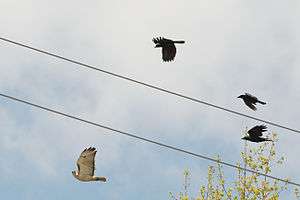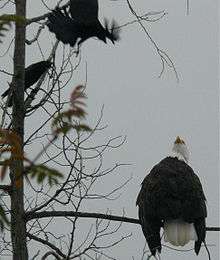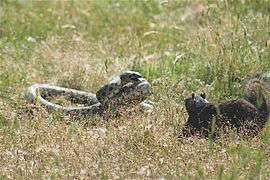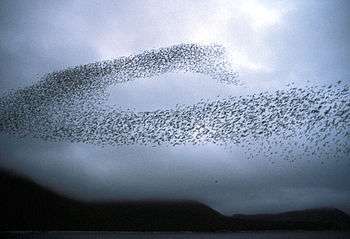Mobbing (animal behavior)

Mobbing in animals is an antipredator adaptation in which individuals of prey species mob a predator by cooperatively attacking or harassing it, usually to protect their offspring. A simple definition of mobbing is an assemblage of individuals around a potentially dangerous predator.[1] This is most frequently seen in birds, though it is also known to occur in many other animals such as the meerkat. While mobbing has evolved independently in many species, it only tends to be present in those whose young are frequently preyed upon. This behavior may complement cryptic adaptations in the offspring themselves, such as camouflage and hiding. Mobbing calls may be used to summon nearby individuals to cooperate in the attack.
Konrad Lorenz, in his book On Aggression (1966), attributed mobbing among birds and animals to instincts rooted in the Darwinian struggle to survive. In his view, humans are subject to similar innate impulses but capable of bringing them under rational control (see mobbing).[2]
In birds



Birds that breed in colonies such as gulls are widely seen to attack intruders, including encroaching humans.[3] In North America, the birds that most frequently engage in mobbing include mockingbirds, crows and jays, chickadees, terns, and blackbirds. Behavior includes flying about the intruder, dive bombing, loud squawking and defecating on the predator. Mobbing can also be used to obtain food, by driving larger birds and mammals away from a food source, or by harassing a bird with food. One bird might distract while others quickly steal food. Scavenging birds such as gulls frequently use this technique to steal food from humans nearby. A flock of birds might drive a powerful animal away from food. Costs of mobbing behavior include the risk of engaging with predators, as well as energy expended in the process. The black-headed gull is a species which aggressively engages intruding predators, such as carrion crows. Classic experiments on this species by Hans Kruuk involved placing hen eggs at intervals from a nesting colony, and recording the percentage of successful predation events as well as the probability of the crow being subjected to mobbing.[4] The results showed decreasing mobbing with increased distance from the nest, which was correlated with increased predation success. Mobbing may function by reducing the predator's ability to locate nests (as a distraction) since predators cannot focus on locating eggs while they are under attack.
Besides the ability to drive the predator away, mobbing also draws attention to the predator, making stealth attacks impossible. Mobbing plays a critical role in the identification of predators and inter-generational learning about predator identification. Reintroduction of species is often unsuccessful, because the established population lacks this cultural knowledge of how to identify local predators. Scientists are exploring ways to train populations to identify and respond to predators before releasing them into the wild.[5]
Adaptationist hypotheses regarding why an organism should engage in such risky behavior have been suggested by Eberhard Curio,[6] including advertising their physical fitness and hence uncatchability (much like stotting behavior in gazelles), distracting predators from finding their offspring, warning their offspring, luring the predator away, allowing offspring to learn to recognize the predator species,[7] directly injuring the predator or attracting a predator of the predator itself. The much lower frequency of attacks between nesting seasons suggests such behavior may have evolved due to its benefit for the mobber's young. Niko Tinbergen argued that the mobbing was a source of confusion to gull chick predators, distracting them from searching for prey .[8] Indeed, an intruding carrion crow can only avoid incoming attacks by facing its attackers, which prevents it from locating its target.[3]
Besides experimental research, the comparative method can also be employed to investigate hypotheses such as those given by Curio above. For example, closely related species such as the kittiwake do not show mobbing behavior. The kittiwake's cliff nests are almost completely inaccessible to possible predators due to gusty winds and sheer cliffs, meaning its young are not at risk to predation like the black-headed gull.[9] This is an example of an evolutionary pattern known as divergent evolution.
Mobbing is thought to carry risks to roosting predators, including potential harm from the mobbing birds, or attracting larger, more dangerous predators. Birds at risk of mobbing such as owls have cryptic plumage and hidden roosts which reduces this danger.[10]
In other animals

Another way the comparative method can be used here is by comparing gulls with distantly related organisms. This approach relies on the existence of convergent evolution, where distantly related organisms evolve the same trait due to similar selection pressures. As mentioned, many bird species such as the swallows also mob predators, however more distantly related groups including mammals have been known to engage in this behavior. One example is the California ground squirrel, which distracts predators such as the rattlesnake and gopher snake from locating their nest burrows by kicking sand into their face, which disrupts the snake's sensory organs; for crotaline snakes, this includes the heat-detecting organs in the loreal pits.[11] This social species also uses alarm calls.
Some fish engage in mobbing; for example, bluegills sometimes attack snapping turtles.[1] Bluegills, which form large nesting colonies, were seen to attack both released and naturally occurring turtles, which may advertise their presence, drive the predator from the area, or aid in the transmission of predator recognition. Similarly, humpback whales are known to mob killer whales when the latter are attacking other species, including other cetacean species, seals, sea lions, and fish.[12]
Mobbing calls
Mobbing calls are signals made by the mobbing species while harassing a predator. These differ from alarm calls, which allow con-specifics to escape from the predator. The great tit, a European songbird, uses such a signal to call on nearby birds to harass a perched bird of prey, such as an owl. This call occurs in the 4.5kHz range,[3] and carries over long distances. However, when their prey are in flight, they employ an alarm signal in the 7–8 kHz range. This call is less effective at traveling great distances, but is much more difficult for both owls and hawks to hear (and detect the direction from which the call came).[13] In the case of the alarm call, it could be disadvantageous to the sender if the predator picks up on the signal, hence selection has favored those birds able to hear and employ calls in this higher frequency range.
Mobbing calls may also be part of an animal's arsenal in harassing the predator. Studies of Phainopepla mobbing calls indicate it may serve to enhance the swooping attack on the predators, including scrub jays. In this species, the mobbing call is smoothly upsweeping, and is made when swooping down in an arc beside the predator. This call was also heard during agonistic behavior interactions with conspecifics, and may serve additionally or alternatively as an alarm call to their mate.[14]
Evolution

The evolution of mobbing behavior can be explained using evolutionarily stable strategies, which are in turn based on game theory.[15]
Mobbing involves risks (costs) to the individual and benefits (payoffs) to the individual and others. The individuals themselves are often genetically related, and mobbing is increasingly studied with the gene-centered view of evolution by considering inclusive fitness (the carrying on of one's genes through one's family members), rather than merely benefit to the individual.
By cooperating to successfully drive away predators, all individuals involved increase their chances of survival and reproduction. An individual stands little chance against a larger predator, but when a large group is involved, the risk to each group member is reduced or diluted. This so-called dilution effect proposed by W. D. Hamilton is another way of explaining the benefits of cooperation by selfish individuals. Lanchester's laws also provide an insight into the advantages of attacking in a large group rather than individually.[16][17]
Another interpretation involves the use of signalling theory, and possibly the handicap principle. Here the idea is that a mobbing bird, by apparently putting itself at risk, displays its status and health so as to be preferred by potential partners.[18]
References
- 1 2 Dominey, Wallace J. (1983). "Mobbing in Colonially Nesting Fishes, Especially the Bluegill, Lepomis macrochirus". Copeia. 1983 (4): 1086–1088. doi:10.2307/1445113. JSTOR 1445113.
- ↑ Kenneth Westheus Mobbing. uwaterloo.ca
- 1 2 3 Alcock, John (1998). Animal Behavior: An Evolutionary Approach (6th ed.). Sunderland: Sinauer Associates. ISBN 0-87893-009-4.
- ↑ Kruuk, H. (1964). Predators and anti-predator behaviour of the black-headed gull Larus ridibundus. Behaviour Supplements (11). Leiden: E.J. Brill. OCLC 1502972.
- ↑ Griffin, Andrea S.; Daniel T. Blumstein; Christopher S. Evans (October 2000). "Training Captive-Bred or Translocated Animals to Avoid Predators". Conservation Biology. 14 (5): 1317–1326. doi:10.1046/j.1523-1739.2000.99326.x.
- ↑ Curio, E. (1978). "The adaptive significance of avian mobbing. I. Teleonomic hypotheses and predictions". Zeitschrift für Tierpsychologie. 48: 175–183.
- ↑ Curio, E.; U. Ernst; W. Vieth (1978). "Cultural Transmission of Enemy Recognition: One Function of Mobbing". Science. 202 (4370): 899–901. doi:10.1126/science.202.4370.899. PMID 17752463.
- ↑ Tinbergen, Niko. The herring gull's world: a study of the social behavior of birds. New York: Lyons and Bulford. ISBN 1-55821-049-0.
- ↑ Cullen, E. (1957). "Adaptations in the kittiwake to cliff nesting". Ibis. 99 (2): 275–302. doi:10.1111/j.1474-919X.1957.tb01950.x.
- ↑ Hendrichsen, Ditte K.; Christiansen, Peter; Nielsen, Elsemarie K.; Dabelsteen, Torben; Sunde, Peter (2006). "Exposure affects the risk of an owl being mobbed – experimental evidence". Journal of Avian Biology. 37 (1): 13–18. doi:10.1111/j.2005.0908-8857.03658.x.
- ↑ Coss, Richard G.; Biardi, J. E. (1997). "Individual Variation in the Antisnake Behavior of California Ground Squirrels (Spermophilus beecheyi)". Journal of Mammalogy. 78 (2): 294–310. doi:10.2307/1382883. JSTOR 1382883.
- ↑ Pitman, Robert; et al. (2016-07-20). "Humpback whales interfering when mammal-eating killer whales attack other species: Mobbing behavior and interspecific altruism?". Marine Mammal Science. doi:10.1111/mms.12343. Retrieved 2016-08-02 – via Wiley Online Library.
- ↑ Brown, C. H. (1982). "Ventriloquial and locatable vocalizations in birds". Zeitschrift für Tierpsychologies. 59: 338–350. doi:10.1111/j.1439-0310.1982.tb00346.x.
- ↑ Leger, Daniel W.; Laura F. Carroll (1981). "Mobbing Calls of the Phainopepla" (PDF). The Condor. 83 (4): 377–380. doi:10.2307/1367509. JSTOR 1367509. Retrieved 2007-06-12.
- ↑ Parker, Geoffrey A., Manfred Milinski (1997). "Cooperation under Predation Risk: A Data-Based ESS Analysis". Proceedings: Biological Sciences. 264 (1385): 1239–1247. doi:10.1098/rspb.1997.0171.
- ↑ Kelly, Kevin (1994). Out of control: the new biology of machines, social systems and the economic world. Boston: Addison-Wesley. ISBN 0-201-48340-8.
- ↑ Hamilton, W. D. (1971). "Geometry for the selfish herd" (PDF). Journal of Theoretical Biology. 31 (2): 295–311. doi:10.1016/0022-5193(71)90189-5. PMID 5104951.
- ↑ Arnold, K. E. (2000). "Group Mobbing Behaviour and Nest Defence in a Cooperatively Breeding Australian Bird" (PDF). Ethology. 106 (5): 385–393. doi:10.1046/j.1439-0310.2000.00545.x.
External links
| Wikimedia Commons has media related to Mobbing. |
- Interspecific reciprocity explains mobbing behaviour of the breeding chaffinches, Fringilla coelebs Paper by Indrikis Krams and Tatjana Krama (PDF)
- Nature Photography – Using mobbing behavior in photography
- Birds mob Puff Adder – paper in ejournal Ornithological Observations
.jpg)
